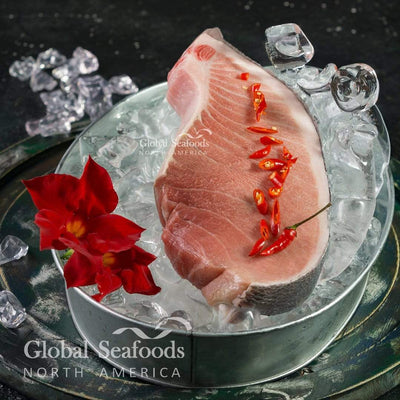Bluefin Tuna Anatomy: Exploring the Speed and Strength of the Ocean’s Predator

Bluefin Tuna Anatomy: Understanding the Ocean's Speedster
Bluefin tuna are among the most prized fish in the world, celebrated for their rich flavor, high-fat content, and firm texture. But these magnificent creatures are more than just a delicacy; they’re marvels of nature, equipped with unique anatomical features that allow them to thrive in the ocean. In this article, we’ll take a closer look at the anatomy of bluefin tuna and explore how their physical adaptations make them one of the most impressive fish in the sea.
Why Bluefin Tuna Are Special
Bluefin tuna are renowned for several unique qualities:
- Unparalleled Speed: These fish can swim up to 45 miles per hour, making them one of the fastest species in the ocean.
- Migratory Powerhouses: Bluefin tuna can travel thousands of miles, crossing entire oceans during their migrations.
- Highly Valued: Their rich, fatty meat is highly sought after for sushi, sashimi, and fine dining, earning them a reputation as one of the most valuable fish globally.
For premium tuna options, explore ahi tuna steaks or bluefin tuna at Global Seafoods.
Anatomy of a Bluefin Tuna
The Head
The head of a bluefin tuna is streamlined and pointed to reduce drag and optimize swimming efficiency.
- Large Eyes: Positioned on either side of the head, these provide excellent peripheral vision, crucial for spotting prey and predators.
- Powerful Jaw: Equipped with sharp teeth, the jaw is designed to catch and hold fast-moving prey like squid and smaller fish.
The Body
The torpedo-shaped body of a bluefin tuna is perfectly adapted for speed and endurance.
- Streamlined Shape: The fish’s body reduces water resistance, enabling it to swim with remarkable efficiency.
- Dermal Denticles: Tiny, tooth-like scales cover the skin, reducing drag and increasing hydrodynamic performance.
- Powerful Muscles: The high concentration of red muscle tissue allows sustained swimming during long migrations.
Looking to enjoy the best of the ocean? Check out sushi-grade tuna saku blocks for your next meal.
The Fins
The fins of a bluefin tuna play an essential role in their mobility and balance.
- Pectoral Fins: Located on either side of the body, these fins help with steering and precise movements.
- Dorsal Fin: Positioned along the back, the dorsal fin stabilizes the fish, preventing rolling during high-speed swimming.
- Anal and Pelvic Fins: These assist with turning and maintaining balance, especially during rapid maneuvers.
The Tail
The tail, also known as the caudal fin, is the powerhouse of the bluefin tuna.
- Crescent Shape: The tail’s large, crescent design enables rapid acceleration and sustained swimming speeds.
- Keels: Ridges near the tail base reduce turbulence and enhance stability, particularly during long-distance travel.
- Adapted for Control: The upper and lower lobes of the tail ensure directional precision and agility.
Adaptations for Speed and Survival
Bluefin tuna have evolved numerous features that give them an edge in the ocean:
- Warm-Blooded: Unlike most fish, bluefin tuna can regulate their body temperature, allowing them to thrive in colder waters.
- Efficient Gills: Their gills extract oxygen efficiently, enabling sustained high-speed swimming.
- Retractable Fins: Their fins can fold into grooves to reduce drag during fast swimming.
Culinary Value of Bluefin Tuna
Bluefin tuna are not only admired for their physical abilities but are also highly prized in the culinary world.
- Rich Flavor: The high-fat content, particularly in the belly (otoro), makes the meat buttery and melt-in-your-mouth delicious.
- Versatile Uses: Bluefin tuna is a favorite in sushi, sashimi, seared dishes, and gourmet steaks.
- Global Demand: Its scarcity and exceptional quality make it one of the most valuable seafood options on the market.
For premium tuna products, try albacore tuna or fresh whole tuna options.
FAQs About Bluefin Tuna
1. What is the average size of a bluefin tuna?
Bluefin tuna can grow up to 10 feet in length and weigh over 1,000 pounds.
2. How long do bluefin tuna live?
These fish can live up to 40 years in the wild, depending on environmental factors and fishing pressures.
3. Why are bluefin tuna so fast?
Their streamlined body, powerful tail, and efficient muscle structure enable them to reach speeds of up to 45 miles per hour.
4. Are bluefin tuna endangered?
Some populations of bluefin tuna are at risk due to overfishing, but conservation efforts are helping to rebuild their numbers.
5. What makes bluefin tuna a delicacy?
The high-fat content, especially in cuts like otoro and chutoro, gives bluefin tuna its rich flavor and tender texture, making it highly sought after.
Conclusion
Bluefin tuna are truly remarkable creatures, both as marine predators and culinary treasures. Their sleek anatomy, powerful muscles, and exceptional speed make them masters of the ocean, while their rich, buttery meat is celebrated worldwide. Understanding the unique anatomy and adaptations of bluefin tuna can deepen your appreciation for these incredible fish.
For top-quality tuna, visit Global Seafoods to explore options like ahi tuna steaks and sushi-grade tuna saku blocks. Don’t forget to check out their YouTube channel for recipes and seafood tips.
Please don’t forget to leave a review.
Also in News

How to Make Sea Bream Sushi With Dry-Aged Tuna & Crab Roll — Step-by-Step With Chef Joshua
A complete guide to making Sea Bream sushi at home, including filleting, curing, slicing, and building a Dry-Aged Tuna & Crab sushi roll. Chef Joshua shares professional tips for restaurant-quality results.

Boiled Crab for Game Night: Everything You Need for a Perfect Seafood Party
Take your game night to the next level with a Boiled crab party. Learn the best recipes, cooking tips, and hosting hacks for a memorable seafood feast.

Boiled Crab for Date Night: A Romantic Guide to the Perfect Seafood Feast
Make your next date night unforgettable with a romantic Boiled crab experience. This guide covers everything you need to know, from ambiance to the best crab varieties.

